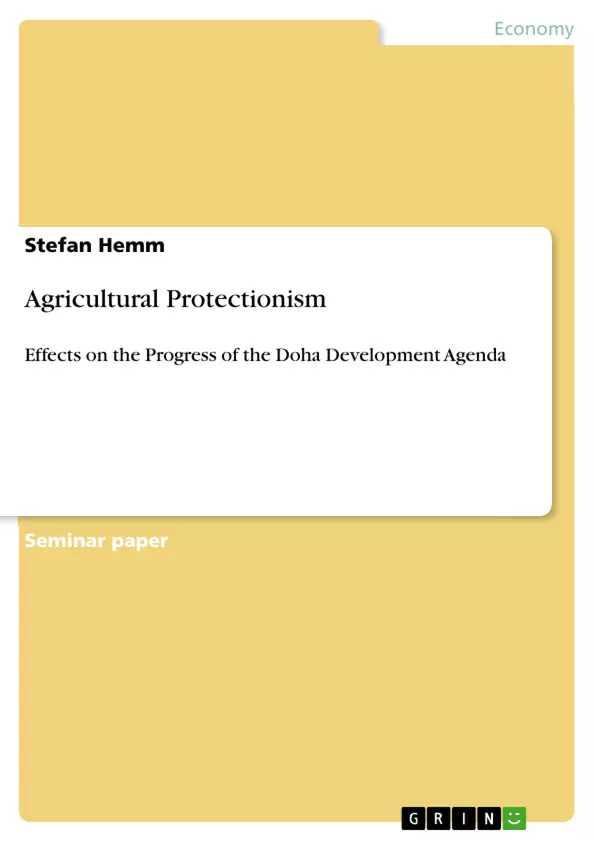Today we live in a globalized world and anybody can buy any product from any country in the world. But that is not completely true. Trade is not as free as many of us always think it is. There are still so many trade barriers which make international trade sometimes such an adventure. The World Trade Organization (WTO) was established to liberalize trade by reducing or eliminating tariffs and any other trade barriers. Therefore, all members have to contribute to that undertaking and make concessions. In the current round, named the Doha Development Agenda this does not work as it was meant to. A crucial issue in that conflict is agriculture. Developing countries and least developed countries complain about large amounts of subsidies paid by high-income countries such as the EU. In contrast, developed countries want developing countries to make concessions in terms of trade related intellectual property rights and trade related investment measures. So each country blames the other one instead of taking action and making the first step.
This essay is structured into two main parts. The first part informs about some basics of protectionism and what happened so far in terms of agricultural liberalization. Chapter two gives a short overview of the existing types of protectionist measures to get a first impression how manifold opportunities for protectionists are. In this case, measures were divided into border measures and non-border measures. Chapter three informs about the outcome of the Uruguay Round, namely the Agreement on Agriculture to give an impression what was the state of WTO negotiations before the Doha Round started and what the impact of the URAA was. All previous rounds are not stated here because the Uruguay Round was the first round to achieve major results in liberalizing agriculture.
The second part of the work describes the actual situation. Chapter 4 starts with the investigation why agricultural issues delay the Doha Development Agenda. Therefore, both sides, namely the developed countries´ view and developing countries´ view, are treated to deliver a balanced picture. Extent and gravity of agricultural tariffs and subsidies are explained in chapter 5. In chapter 6 the results of two major studies are presented to get an impression how much benefits are at stake for negotiation partners. In the last chapter I make some concluding remarks and try to give a future outlook how the fiasco of trade negotiation might be resolved.
Inhaltsverzeichnis (Table of Contents)
- Introduction
- Types of protectionist measures
- Border measures
- Non-border measures
- Outcome of the Uruguay Round
- Export subsidies
- Market access
- Domestic support
- Impact of URAA
- Agricultural issues delay the DDA
- Developed countries' point of view
- Developing countries' point of view
- Extent and gravity of agricultural subsidies and tariffs
- Agricultural tariffs
- Agricultural subsidies
- Beneficiaries of liberalization in agriculture
- Analysis by Anderson et al. (2006)
- Analysis by Adler et al. (2009)
- Concluding Thoughts and Outlook
Zielsetzung und Themenschwerpunkte (Objectives and Key Themes)
This essay aims to investigate the impact of agricultural protectionism on the progress of the Doha Development Agenda. The essay provides a background on the types of protectionist measures and the outcome of the Uruguay Round, focusing on the Agreement on Agriculture. It then explores the reasons why agricultural issues have delayed the DDA, analyzing the perspectives of both developed and developing countries. The essay further examines the extent and gravity of agricultural tariffs and subsidies before concluding with a discussion of the beneficiaries of liberalization in agriculture.
- Impact of agricultural protectionism on the Doha Development Agenda
- Types of protectionist measures and their effects on trade
- Agricultural liberalization and the outcome of the Uruguay Round
- Perspectives of developed and developing countries regarding agricultural trade
- Benefits of liberalization in agriculture and potential beneficiaries
Zusammenfassung der Kapitel (Chapter Summaries)
The essay begins by outlining the complex nature of international trade and the role of trade barriers. It highlights the World Trade Organization's (WTO) mission to liberalize trade and the challenges faced by the Doha Development Agenda (DDA) in achieving this goal, specifically in the area of agriculture.
Chapter 2 introduces the reader to the different types of protectionist measures employed by countries, distinguishing between border and non-border measures. It provides a comprehensive overview of various trade barriers, including tariffs, quotas, variable import levies, health and sanitary requirements, and state trading organizations. The chapter also briefly discusses export incentives, drawing attention to their role in influencing agricultural trade.
Chapter 3 delves into the outcome of the Uruguay Round, specifically the Agreement on Agriculture. It examines the progress made in agricultural liberalization before the start of the DDA, highlighting the importance of the Uruguay Round as the first major effort to liberalize agricultural trade.
Chapter 4 focuses on the reasons behind the delay in the DDA, particularly highlighting the role of agricultural issues. It presents contrasting perspectives from developed and developing countries regarding trade barriers and subsidies, shedding light on the complex dynamics surrounding agricultural trade negotiations.
Chapter 5 examines the extent and significance of agricultural tariffs and subsidies, providing a detailed analysis of their impact on agricultural trade. It explores how these measures affect both domestic and international markets, highlighting the challenges associated with reaching a consensus on their reduction or elimination.
Chapter 6 presents two major studies that analyze the benefits of liberalization in agriculture, emphasizing the potential gains for different stakeholders. By examining the findings of Anderson et al. (2006) and Adler et al. (2009), the chapter provides a comprehensive understanding of the economic and social implications of reducing trade barriers in agriculture.
Schlüsselwörter (Keywords)
The key themes and concepts addressed in this essay include agricultural protectionism, trade liberalization, the Doha Development Agenda (DDA), the Uruguay Round, Agreement on Agriculture, tariffs, subsidies, export incentives, non-tariff barriers, developing countries, developed countries, and the benefits of liberalization in agriculture.
- Arbeit zitieren
- B.A. Stefan Hemm (Autor:in), 2011, Agricultural Protectionism, München, GRIN Verlag, https://www.grin.com/document/193427



